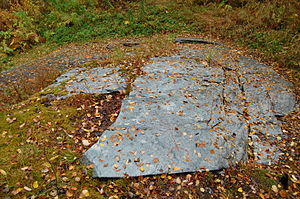
Troms is a former county in northern Norway. On 1 January 2020 it was merged with the neighboring Finnmark county to create the new Troms og Finnmark county. This merger is expected to be reversed by the government resulting from the 2021 Norwegian parliamentary election.

Målselv is a municipality in Troms og Finnmark county, Norway. The administrative centre of the municipality is the village of Moen. The main commercial centre of the municipality is the Bardufoss area. Other villages in the municipality include Alappmoen, Fossmoen, Holmen, and Skjold. Besides bordering Sweden to the east and the ocean to the northwest, it borders the municipalities of Balsfjord, Storfjord, Bardu, Sørreisa, and Lenvik.
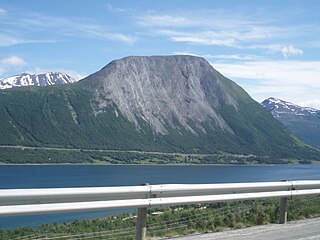
Balsfjord is a municipality in Troms og Finnmark county, Norway. The administrative centre of the municipality is the village of Storsteinnes. Other villages include Mestervik, Mortenhals, and Nordkjosbotn.

Skjervøy kommune is a municipality in Troms og Finnmark county, Norway. The administrative centre of the municipality is the town of Skjervøy on the island of Skjervøya, where most of the inhabitants live. The main industries are fishing and shipbuilding.
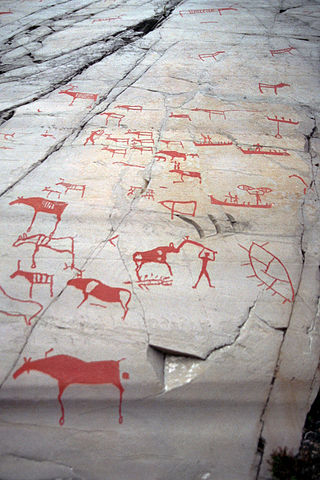
The Rock art of Alta are located in and around the municipality of Alta in the county of Troms og Finnmark in northern Norway. Since the first carvings were discovered in 1973, more than 6,000 carvings have been found on several sites around Alta. The largest locality, at Jiepmaluokta about five kilometers (3.1 mi) from Alta, contains thousands of individual carvings and has been turned into an open-air museum. The site, along with the sites Storsteinen, Kåfjord, Amtmannsnes, and Transfarelv, was placed on the UNESCO list of World Heritage Sites on 3 December 1985. It is Norway's only prehistoric World Heritage Site.
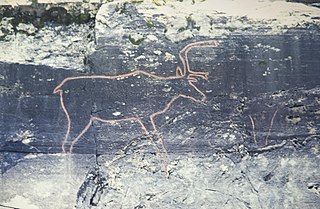
Central Norway is a region in Norway, comprising Trøndelag as well as parts of the Nordland and Møre og Romsdal counties.

Skjomen (Norwegian) or Skievvá (Northern Sami) is a small fjord that branches off from the main Ofotfjorden in Narvik Municipality in Nordland county, Norway. It is located in the Ofoten district in Northern Norway, just south of the town of Narvik. The European route E6 highway crosses the Skjomen fjord over the Skjomen Bridge, just south of the mouth of the fjord.
The rock carvings at Åsli are located near the Malangen in Balsfjord municipality in Norway comprise at least 15 figures in poor condition. The figures are from a hunting culture.

The Rock carvings at Møllerstufossen in Nord-Sinni in Nordre Land municipality in Oppland county of Norway comprise several carvings of moose and one other animal. The site covers about 20 m². The largest figure measures about 90 cm across. The figures are carved with deep and wide strokes and are easy to spot.

Mestervik Chapel is a chapel of the Church of Norway in Balsfjord Municipality in Troms og Finnmark county, Norway. It is located in the village of Mestervik. It is an annex chapel for the Malangen parish which is part of the Senja prosti (deanery) in the Diocese of Nord-Hålogaland. The white, wooden chapel was originally a school and it was rebuilt in a long church design in 1968 using plans drawn up by the architect Kjell Hansen. The church seats about 100 people.
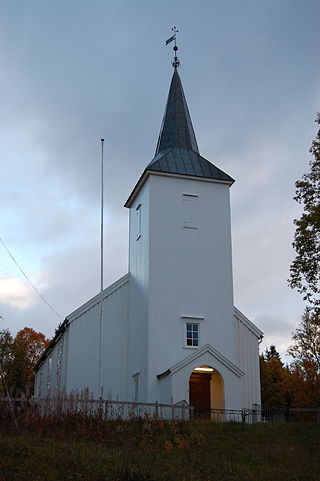
Malangen Church is a parish church of the Church of Norway in Balsfjord Municipality in Troms og Finnmark county, Norway. It is located in the village of Mortenhals. It is the church for the Malangen parish which is part of the Senja prosti (deanery) in the Diocese of Nord-Hålogaland. The white, wooden church was built in a long church style in 1853 by local builders. The church seats about 280 people. The building was consecrated on 31 August 1853.

Storsteinnes Chapel is a parish church of the Church of Norway in Balsfjord Municipality in Troms og Finnmark county, Norway. It is located on the south side of the village of Storsteinnes. It is one of the churches for the Balsfjord parish which is part of the Senja prosti (deanery) in the Diocese of Nord-Hålogaland. The white, wooden church was built in a long church style in 1968. The church seats about 200 people.
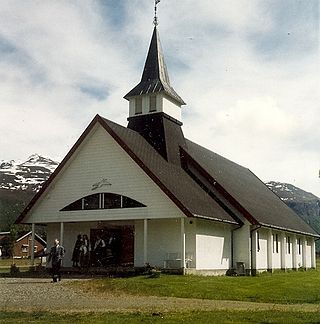
Nordkjosbotn Church is a chapel of the Church of Norway in Balsfjord Municipality in Troms og Finnmark county, Norway. It is located in the village of Nordkjosbotn. It is one of the churches for the Balsfjord parish which is part of the Senja prosti (deanery) in the Diocese of Nord-Hålogaland. The white, wood and aggregate concrete church was built in a long church style in 1987 using plans drawn up by the architect Åge Pedersen. The church seats about 260 people.
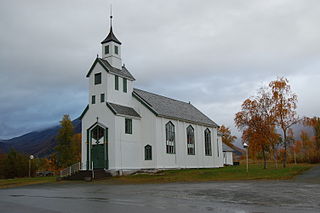
Balsfjord Church is a parish church of the Church of Norway in Balsfjord Municipality in Troms og Finnmark county, Norway. It is located at Balsfjord, just north of the village of Tennes. It is one of the churches for the Balsfjord parish which is part of the Senja prosti (deanery) in the Diocese of Nord-Hålogaland. The white, wooden church was built in a long church style in 1856 using plans drawn up by the architect Christian Heinrich Grosch. The church seats about 400 people.
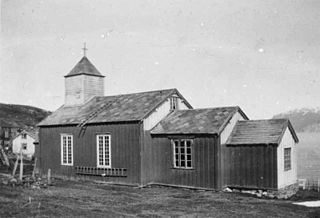
Skorpa Church is a historic parish church of the Church of Norway in Kvænangen Municipality in Troms og Finnmark county, Norway. It is located on the small island of Skorpa. It used to be the church for the Kvænangen parish which is part of the Nord-Troms prosti (deanery) in the Diocese of Nord-Hålogaland. The white, wooden church was built in a long church style in 1850 using plans drawn up by an unknown architect. The church seats about 300 people. In 1956, the church was taken out of regular use when the new Sekkemo Church was completed on the mainland.

Slotten Church is a parish church of the Church of Norway in Måsøy Municipality in Troms og Finnmark county, Norway. It is located in the village of Slåtten on the mainland part of the island municipality. It is one of the churches for the Måsøy parish which is part of the Hammerfest prosti (deanery) in the Diocese of Nord-Hålogaland. The white, wooden church was built in a long church style in 1963 using plans drawn up by the architect Rolf Harlew Jenssen. The church seats about 100 people.

Troms og Finnmark, is a county under disestablishment in northern Norway that was established on 1 January 2020 as the result of a regional reform. It is the largest county by area in Norway, encompassing about 75,000 square kilometres (29,000 sq mi), and was formed by the merger of the former Finnmark and Troms counties in addition to Tjeldsund Municipality from Nordland county.

Bølareinen is the name of the primary motif in a large petroglyph site in Stod in Steinkjer municipality, Norway. It is sometimes referred to as Bølafeltet. The Bølarein has been mentioned as "probably the most well known of all the Norwegian petroglyphs", and as "the finest rock carving we have in our country."
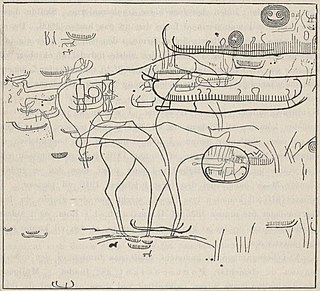
The Bardal rock carvings is a large collection of petroglyphs on Bardal Farm in Steinkjer, Trøndelag, Norway. What makes the rock carvings at Bardal especially noteworthy is the presence of figures from the Stone Age, Bronze Age and Iron Age all on the same rock surface, with the newer figures having been carved on top of figures from the Stone Age. For thousands of years, from 4000 BCE to Year 0, people carved figures into rock at Bardal.

